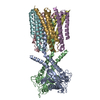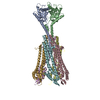[English] 日本語
 Yorodumi
Yorodumi- EMDB-43562: Cryo-EM structure of a type I ZorAB complex from Shewanella sp. s... -
+ Open data
Open data
- Basic information
Basic information
| Entry |  | |||||||||
|---|---|---|---|---|---|---|---|---|---|---|
| Title | Cryo-EM structure of a type I ZorAB complex from Shewanella sp. strain ANA-3, PG-binding domain focused map | |||||||||
 Map data Map data | sharpened map from PG-binding domain focused refinement | |||||||||
 Sample Sample |
| |||||||||
 Keywords Keywords | phage defense / zorya / phage / membrane protein complex / MEMBRANE PROTEIN | |||||||||
| Biological species |  Shewanella sp. ANA-3 (bacteria) Shewanella sp. ANA-3 (bacteria) | |||||||||
| Method | single particle reconstruction / cryo EM / Resolution: 2.4 Å | |||||||||
 Authors Authors | Deme JC / Lea SM | |||||||||
| Funding support |  United States, 1 items United States, 1 items
| |||||||||
 Citation Citation |  Journal: Nat Commun / Year: 2025 Journal: Nat Commun / Year: 2025Title: Modularity of Zorya defense systems during phage inhibition. Authors: Giuseppina Mariano / Justin C Deme / Jennifer J Readshaw / Matthew J Grobbelaar / Mackenzie Keenan / Yasmin El-Masri / Lindsay Bamford / Suraj Songra / Tim R Blower / Tracy Palmer / Susan M Lea /   Abstract: Bacteria have evolved an extraordinary diversity of defense systems against bacteriophage (phage) predation. However, the molecular mechanisms underlying these anti-phage systems often remain elusive. ...Bacteria have evolved an extraordinary diversity of defense systems against bacteriophage (phage) predation. However, the molecular mechanisms underlying these anti-phage systems often remain elusive. Here, we provide mechanistic and structural insights into Zorya phage defense systems. Using cryo-EM structural analyses, we show that the Zorya type I and II core components, ZorA and ZorB, assemble in a 5:2 complex that is similar to inner-membrane ion-driven, rotary motors that power flagellar rotation, type 9 secretion, gliding and the Ton nutrient uptake systems. The ZorAB complex has an elongated cytoplasmic tail assembled by bundling the C-termini of the five ZorA subunits. Mutagenesis demonstrates that peptidoglycan binding by the periplasmic domains of ZorB, the structured cytoplasmic tail of ZorA, and ion flow through the motor is important for function in both type I and II systems. Furthermore, we identify ZorE as the effector module of the Zorya II system, possessing nickase activity. Our work reveals the molecular basis of the activity of Zorya systems and highlights the ZorE nickase as crucial for population-wide immunity in the type II system. | |||||||||
| History |
|
- Structure visualization
Structure visualization
| Supplemental images |
|---|
- Downloads & links
Downloads & links
-EMDB archive
| Map data |  emd_43562.map.gz emd_43562.map.gz | 398.6 MB |  EMDB map data format EMDB map data format | |
|---|---|---|---|---|
| Header (meta data) |  emd-43562-v30.xml emd-43562-v30.xml emd-43562.xml emd-43562.xml | 14.9 KB 14.9 KB | Display Display |  EMDB header EMDB header |
| FSC (resolution estimation) |  emd_43562_fsc.xml emd_43562_fsc.xml | 17.9 KB | Display |  FSC data file FSC data file |
| Images |  emd_43562.png emd_43562.png | 97.1 KB | ||
| Masks |  emd_43562_msk_1.map emd_43562_msk_1.map | 421.9 MB |  Mask map Mask map | |
| Filedesc metadata |  emd-43562.cif.gz emd-43562.cif.gz | 4.2 KB | ||
| Others |  emd_43562_additional_1.map.gz emd_43562_additional_1.map.gz emd_43562_half_map_1.map.gz emd_43562_half_map_1.map.gz emd_43562_half_map_2.map.gz emd_43562_half_map_2.map.gz | 211.2 MB 391.9 MB 391.9 MB | ||
| Archive directory |  http://ftp.pdbj.org/pub/emdb/structures/EMD-43562 http://ftp.pdbj.org/pub/emdb/structures/EMD-43562 ftp://ftp.pdbj.org/pub/emdb/structures/EMD-43562 ftp://ftp.pdbj.org/pub/emdb/structures/EMD-43562 | HTTPS FTP |
-Validation report
| Summary document |  emd_43562_validation.pdf.gz emd_43562_validation.pdf.gz | 1 MB | Display |  EMDB validaton report EMDB validaton report |
|---|---|---|---|---|
| Full document |  emd_43562_full_validation.pdf.gz emd_43562_full_validation.pdf.gz | 1 MB | Display | |
| Data in XML |  emd_43562_validation.xml.gz emd_43562_validation.xml.gz | 25.3 KB | Display | |
| Data in CIF |  emd_43562_validation.cif.gz emd_43562_validation.cif.gz | 33 KB | Display | |
| Arichive directory |  https://ftp.pdbj.org/pub/emdb/validation_reports/EMD-43562 https://ftp.pdbj.org/pub/emdb/validation_reports/EMD-43562 ftp://ftp.pdbj.org/pub/emdb/validation_reports/EMD-43562 ftp://ftp.pdbj.org/pub/emdb/validation_reports/EMD-43562 | HTTPS FTP |
-Related structure data
- Links
Links
| EMDB pages |  EMDB (EBI/PDBe) / EMDB (EBI/PDBe) /  EMDataResource EMDataResource |
|---|
- Map
Map
| File |  Download / File: emd_43562.map.gz / Format: CCP4 / Size: 421.9 MB / Type: IMAGE STORED AS FLOATING POINT NUMBER (4 BYTES) Download / File: emd_43562.map.gz / Format: CCP4 / Size: 421.9 MB / Type: IMAGE STORED AS FLOATING POINT NUMBER (4 BYTES) | ||||||||||||||||||||||||||||||||||||
|---|---|---|---|---|---|---|---|---|---|---|---|---|---|---|---|---|---|---|---|---|---|---|---|---|---|---|---|---|---|---|---|---|---|---|---|---|---|
| Annotation | sharpened map from PG-binding domain focused refinement | ||||||||||||||||||||||||||||||||||||
| Projections & slices | Image control
Images are generated by Spider. | ||||||||||||||||||||||||||||||||||||
| Voxel size | X=Y=Z: 0.723 Å | ||||||||||||||||||||||||||||||||||||
| Density |
| ||||||||||||||||||||||||||||||||||||
| Symmetry | Space group: 1 | ||||||||||||||||||||||||||||||||||||
| Details | EMDB XML:
|
-Supplemental data
-Mask #1
| File |  emd_43562_msk_1.map emd_43562_msk_1.map | ||||||||||||
|---|---|---|---|---|---|---|---|---|---|---|---|---|---|
| Projections & Slices |
| ||||||||||||
| Density Histograms |
-Additional map: unsharpened map from PG-binding domain focused refinement
| File | emd_43562_additional_1.map | ||||||||||||
|---|---|---|---|---|---|---|---|---|---|---|---|---|---|
| Annotation | unsharpened map from PG-binding domain focused refinement | ||||||||||||
| Projections & Slices |
| ||||||||||||
| Density Histograms |
-Half map: half map 1, PG-binding domain focused refinement
| File | emd_43562_half_map_1.map | ||||||||||||
|---|---|---|---|---|---|---|---|---|---|---|---|---|---|
| Annotation | half map 1, PG-binding domain focused refinement | ||||||||||||
| Projections & Slices |
| ||||||||||||
| Density Histograms |
-Half map: half map 2, PG-binding domain focused refinement
| File | emd_43562_half_map_2.map | ||||||||||||
|---|---|---|---|---|---|---|---|---|---|---|---|---|---|
| Annotation | half map 2, PG-binding domain focused refinement | ||||||||||||
| Projections & Slices |
| ||||||||||||
| Density Histograms |
- Sample components
Sample components
-Entire : ZorAB complex
| Entire | Name: ZorAB complex |
|---|---|
| Components |
|
-Supramolecule #1: ZorAB complex
| Supramolecule | Name: ZorAB complex / type: complex / ID: 1 / Parent: 0 / Macromolecule list: #1-#4 |
|---|---|
| Source (natural) | Organism:  Shewanella sp. ANA-3 (bacteria) Shewanella sp. ANA-3 (bacteria) |
-Experimental details
-Structure determination
| Method | cryo EM |
|---|---|
 Processing Processing | single particle reconstruction |
| Aggregation state | particle |
- Sample preparation
Sample preparation
| Buffer | pH: 8 |
|---|---|
| Vitrification | Cryogen name: ETHANE |
- Electron microscopy
Electron microscopy
| Microscope | TFS KRIOS |
|---|---|
| Image recording | Film or detector model: FEI FALCON IV (4k x 4k) / Average electron dose: 54.0 e/Å2 |
| Electron beam | Acceleration voltage: 300 kV / Electron source:  FIELD EMISSION GUN FIELD EMISSION GUN |
| Electron optics | Illumination mode: FLOOD BEAM / Imaging mode: BRIGHT FIELD / Nominal defocus max: 2.0 µm / Nominal defocus min: 0.5 µm |
| Experimental equipment |  Model: Titan Krios / Image courtesy: FEI Company |
 Movie
Movie Controller
Controller








 Z (Sec.)
Z (Sec.) Y (Row.)
Y (Row.) X (Col.)
X (Col.)





















































